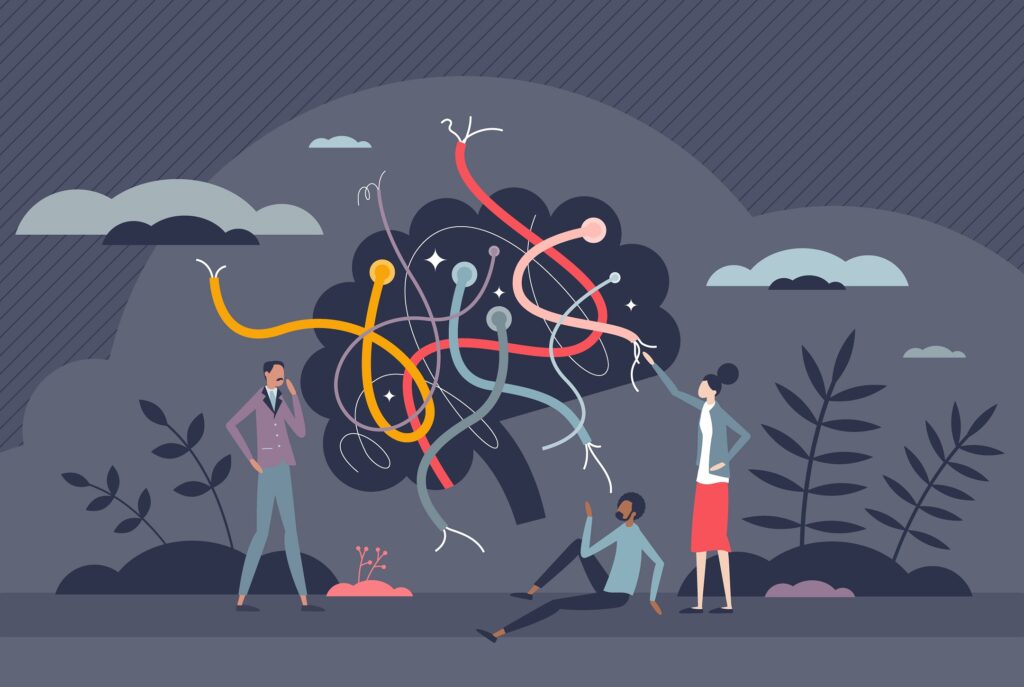In November of 2005, my seventeen-year-old daughter was involved in a car accident. She was making a U-turn and her little Toyota was t-boned by a van. The bumper of the van actually struck her left temple but the damage to her brain was on the right side, since her brain kept moving, slamming into the right side of her skull. She was in a coma for two weeks and in the hospital for over a month as she relearned how to swallow, walk, talk, and move again. The rehab was intense and focused.
Today, she lives independently and works as a teacher’s aide for special-needs students. She was also able to earn her associate degree from the local university. However, eighteen years later, rehabilitation to assist her brain function remains an ongoing process. This type of post-TBI neuro-rehab is common. It was during that time I learned about neuroplasticity, which is the brain’s ability to work around an injury to restore as much normal function as possible. Neuroplasticity was the medical concept that gave me hope, even when my daughter was lying comatose in the ICU.

Everyone knows being struck really hard in the head can cause significant physical damage. The medical community actually excels at treating this type of trauma, given its concrete nature. What is more concrete than the bumper of a van meeting a human skull? The physical therapists, speech therapists, and occupational therapists all worked tirelessly to aid in my daughter’s recovery and the therapy didn’t stop upon leaving the hospital. It may seem unfair, but the rehabilitation must remain an ongoing, lifelong process for her.
So, what does rehabilitation from a traumatic brain injury have to do with being the spouse or support person for someone dealing with the negative impacts of psychiatric medications? From my perspective, as I continue supporting my wife, it is the exact same process.
Even before my daughter’s car accident, I was a strong believer that all the things we value about the people in our lives, people we love, are a direct result of their brains. The brain is what makes us human to each other and, unlike our other organs, it is designed to move our body through, and interact with, the outside world. The brain does this primarily by being the world’s most effective prediction machine, even though most of its predictions occur on an unconscious level.
While it is easy to understand therapies for blunt force trauma, it is much more difficult for medical professionals to see how the drugs they prescribe may impact their patients much like a fast-moving vehicle. What does the brain unconsciously predict when a pill that disrupts its normal function is taken every day, or conversely, when a pill that was taken every day is suddenly stopped? The science about what happens isn’t even disputed—it’s why the drugs exist in the first place. The medications are given for the specific purpose of disrupting brain function in the patient. When that disruption proves harmful, doctors are loath to acknowledge that they were driving the van that struck the patient’s head. Fighting that medical skepticism and denial, while providing reaffirmation to your loved one, becomes a key role for the spouse or family support person.
I met my wife, J.A. Carter-Winward, a couple of years after my daughter’s car accident. We married in August of 2008. I had already learned a lot of therapeutic approaches to traumatic brain injuries, but more importantly, I had also learned something else about head injuries—the total uniqueness of each injury. Each injury is unique because each brain is unique. Remember, the purpose of the brain is to predict so that you can move safely through the world. The brain is going to make those predictions based on past input. Every life has different input and experiences prior to the brain injury, so every brain injury, even in the same location, will result in different manifestations of dysfunction.
For example, one common effect of brain injuries is seizures. My daughter developed full-blown epilepsy after her injury, so I became familiar with various types of seizures: absence, focal aware, focal unaware, and even grand mal. Most of my daughter’s attacks were absence or focal unaware seizures and they followed the same pattern: an aura, the absence (or ictal) phase, followed by the postictal phase. The postictal phase was usually accompanied by aphasia (inability to speak) and fatigue.
Early on in my relationship with J.A., I watched her have a seizure. She had the aura. She had the absence phase. As she came out of the seizure, she was aphasic and exhausted. As she stumbled to speak, teary and fearful, she desperately tried to explain to me that this was some aspect of her diagnosed mental illness, since that was what doctors and therapists had told her. I was a little incredulous. “I’m not sure what your doctors are talking about,” I said. “That was a seizure. You just had a seizure. I’ve seen too many of them to not know one when I see one.” It was J.A.’s turn to be incredulous. She hadn’t known.
Learning that J.A. had seizures took that aspect of her mental health diagnosis and placed it firmly in the realm of the concrete and physical for us. Now, over a decade and a half after that conversation, I have a much better perspective on the seizures. We spent too much time over the years trying to figure out their exact cause, when the reality was simple—–a combination of the medications J.A. had been given, along with past head trauma. Incidentally, the precipitating event for J.A. being put on psychiatric medications before we met was a seizure, probably from an earlier head injury. She’d had the aura, ictal, and postictal phases, the last leaving her so exhausted she’d been unable to get out of the bathtub.
When she recovered enough to speak, she called her then-neuropsychologist, who told her the incident was a case of the “brain flu,” and she immediately got J.A. in to see one of the foremost experts in the fields of psychiatry in Utah, a “bipolar expert.” The psychiatrist, stuck in the mental health paradigm, gave short shrift to what actually happened, and instead of diagnosing a seizure where the postictal phase left her lying in a cold tub, she was told she had a “bi-polar freak-out.” This original prescribing psychiatrist then proceeded to violate every warning for a patient suffering seizures. I found an old (2002) abstract on the NIH website on medicating patients after a seizure and the polydrug prescriptions the doctor handed out violated every single recommendation. Instead of the cocktail he prescribed, the proper approach to lower seizure risk was only low doses of medications and simple therapies that avoided complex drug combinations.
At this point, I can’t even remember the last time J.A. had a seizure, but she hasn’t had one for a couple of years now. The epileptic/brain injury model for avoiding seizure triggers involves lowering stress, getting adequate sleep, avoiding alcohol, and eating regularly, all things we have incorporated into our daily routines. The epileptic is also warned to adhere to the prescribed medication regime to avoid seizures. Medication changes can trigger seizures. We’ve been doing a much slower taper on the remaining psychiatric medications to mitigate the severity of all withdrawal symptoms, which, for J.A., also includes seizures. When we withdrew too quickly from the atypical antipsychotic, Latuda, seizures were frequent.
As I was writing this, I realized that I was using the pronoun “we” to describe the withdrawal. For clarity, I should note that I was not withdrawing from the medication, J.A. was, but the process of withdrawal is something we experience as a couple, even though the actual experience of withdrawal is vastly different for her as a participant than for me as an observer and supporter.
The point about the seizures is that these drugs cause actual, physical disruption to brain function, and even altering the prescription regime can trigger seizures. When we learned J.A. was suffering from akathisia, I started researching akathisia. I even bought a textbook from 1995 whose main focus, according to the blurb on Amazon, was “on drug-induced akathisia and its various subtypes.” One of the first things I learned is that the pathophysiology of akathisia is unknown, although the cause was most often medications.
During severe bouts, akathisia mirrors seizure behavior because it overtakes the ability to function, and then subsides into a more manageable state with time. Some of those who suffer from akathisia have described this process as “windows” and “waves.” The job of the family or support person is to keep the person safe during the waves of attack while realizing that during its acute phases, it is not something within the person’s control. It would be callous, cruel, and misguided to even suggest that an overwhelming neurological event is somehow in the victim’s control.
Of course, it is always a tightrope we must walk. Our loved ones are ultimately in charge of taking whatever necessary and available steps to explore recovery. In the support role, we can offer encouragement and validation, but there are things that remain outside our control. Of all the benefits of looking at harm from medication as a brain injury rather than through a mental health lens, the most helpful is how that allows you to address recovery with your suffering family member.
Despite all of the label-fests urging us to embrace mental illness and the attempts to create acceptance on social media, the mere mention of mental illness conjures concepts of instability and unreliability in our collective mind. Even if those words are never spoken aloud, bringing up a mental illness diagnosis carries a heavy undercurrent of blame and mistrust that hampers healing. For example, the National Institute of Health leads in their curriculum on Mental Illness and the Brain with, “At this time, most mental illnesses cannot be cured, but they can usually be treated effectively to minimize the symptoms and allow the individual to function in work, school, or social environments.” (Emphasis added.)
Contrast that with the hopefulness found on the NIH’s site on brain trauma: “A variety of treatments can help a person recover from TBI and can sometimes reduce or eliminate certain physical, emotional, and cognitive problems associated with TBI. The specifics of treatment, including the type, setting, and length, depend on how severe the injury is and the area of the brain that was injured.” (Emphasis added.)
Recovering from psychiatric drug harm is difficult enough without the added pressure on the patient to resolve an underlying, incurable mental illness that caused the medication to be taken in the first place. This attitude also lets prescribers and drug manufacturers off the hook, since the drug harm can always be blamed on the mental health diagnosis. Leading instead with healing brain trauma for all of the conditions removes the negative and judgmental underpinnings and focuses directly on the problems. And while I’ve been focused on brain trauma caused by medications, I’m certainly in the camp that believes that past emotional and physical trauma also impact brain function, partly because that is exactly how the brain works. It will try to keep us from suffering those same traumas by predicting, sometimes poorly, how we must act or behave. As family support people for those caught in the mental health system, our job is to mitigate as much of the trauma as we can. The first step is to escape, with our family members, from the idea of incurable mental illness.
As I wrote in my earlier article, when J.A. came off the atypical antipsychotic several years ago, the result had no correlation to a mental health diagnosis. Cervical dystonia and tardive dyskinesia and tardive akathisia were clear manifestations of a brain injury caused by the drugs, not mental illness. While brain injuries are horrific, this shift in our thinking helped us focus on what could be done on those specific issues. There was no more talk of mental illness.
In closing, I have never found any of the mental illness diagnoses helpful as a family member and spouse while dealing with medication harm. When there is no pathophysiology to attribute to the illness, you are completely in the dark about treatment options, as are most medical providers. And unfortunately, a mental illness diagnosis is usually accompanied by medication or medications whose continued use and/or withdrawal only adds to the trauma. This is why looking at J.A.’s condition as a brain injury instead creates hope and more avenues to explore healing.
Healing brain trauma is all about neuroplasticity and training the brain around and through the trauma. The phrase “neurons that fire together, wire together” is the foundational mantra for any neuro-rehab. For over a decade, J.A. dutifully used the medications she was given. Those drugs changed how her neurons fired and wired and, according to numerous studies, antipsychotics actually change brain structure. Only as we remove the drugs do we see the damage they cause.
J.A. hinted at neuro-rehab in her last article for Mad in America, “Waking From the Nightmare: Is Recovery From Akathisia Possible?” and she will be expanding on this in future articles as well. Her article was focused on akathisia, so she didn’t really clarify that the neuro-rehab she went through is the reason she no longer suffers from cervical dystonia. Occasionally, she will go through a withdrawal cycle, which is almost like the brain remembering where it was when she withdrew from the atypical antipsychotic and other psychiatric drugs, and some of the symptoms will reappear. However, thanks to the skills she has developed over the years, with each cycle she recovers faster and with more resiliency. It is exactly the “reduction and elimination of problems” that the NIH suggested was possible in healing from brain trauma. Her continued improvement is further proof that the neuro-rehab path was the beneficial path.
And this is the hard part of any neuro-rehabilitation: it takes time and mountains of effort, but in the end, the results are more than worth it. When I was visiting my father in a rehab hospital after he had hip replacement surgery, he was propped up in bed, immobile. Dad looked at me with a twinkle in his eye and said, “You know the difference between a physical therapist and a terrorist? You can negotiate with a terrorist.” My dad knew what he was talking about. The truth in that joke is that recovery can only come with an unyielding doggedness, which often requires outside help, in addition to an unyielding determination on the part of the injured. This is why finding a functional traumatic brain injury provider was vital for us. Also of great importance was finding therapies that supported the neural-rewiring necessary for brain healing from trauma.
Yet, as I said earlier, each injury from these medications and each injury or susceptibility that led to a loved one’s mental health diagnosis creates a unique set of problems and dysfunctions. There is no single process that can be adopted or followed to reach a final result, but the shift to the paradigm that J.A. was neurologically injured, not mentally ill, provided a solid emotional foundation for supporting her and opened up avenues of treatment that we might have ignored had we stuck to the traditional medical model of care for mental illness.
Because our philosophical (and other) approaches to healing often clash with more traditional treatments, my next article will explore how to communicate more effectively with medical professionals so that your loved ones can get the treatment they need and deserve.















Hello, Kent,
it’s good to see you sharing again. I appreciate this article. My wife has also experienced mini-seizures as I always call them as she has healed from her extreme dissociation from the trauma she experienced as a toddler. I have also relied on the concepts of neuroplasticity to help her heal from that extreme dissociation as I have helped her brain essentially rewire itself. We were fortunate, however, not to be caught up in the mental health system and the toxic drugs they give people.
Take care,
Sam
Report comment
This is one of the best and clearest explanations I have seen of what happens in post-withdrawal (aka psychiatric drug injury). I explained it to my family member, who is in the process of recovery from same, as being like “a chemical concussion.”
It’s helpful to remember that the everyday miracle of neuroplasticity gives reason for hope.
Report comment
We assume that the brain is a very important organ to human life, even though there are a few rare examples of people managing with almost no brain tissue. And there is no physical reason to doubt the importance of the brain, which is why scientists study the nervous system and why neurologists exist.
But it has been demonstrated quite thoroughly that people can leave their bodies, remember exactly what happened while they were “away,” and return with a perfectly healthy outlook on life, if not an improved one. Thus, the brain cannot contain the mind or personality. It’s simply impossible and this has been verified by numerous observations.
So we really need to recognize that something else is going on. Now if a person suffers a brain injury in an accident, or from ECT, or for some other reason, physical therapy and some sort of neurological handling will probably be part of their recovery process. But this website covers the subject of “mental illness” and “personality disorders” and if we don’t get it straight that these are NOT brain issues, we will never arrive at a proper understanding of what we are up against or what to do about it.
The experience of going exterior is often a part of this process. And while I don’t recommend having an NDE as the way to have such an experience, there are other ways that are much more benign and non-traumatic, and I would hope that this experience will become available to more people. Meanwhile, the rest of us need to pay some attention to such research, instead of pretending that it doesn’t even exist. It does exist, it is important, and if you really want to resolve the subject of mental health, it is required reading.
Report comment
SO true. I also think that transcendental meditation should be taught to people with any kind of brain injury, emotional trauma, etc. It cannot be just any kind of meditation, it must be transcendental and I am betting YOU know why!
It’s so easy to do, I couldn’t believe it. I’d never been able to “empty my mind”, then I found out through T.M. that we’re not supposed to try to empty our minds.
TM is an organization run through The David Lynch Foundation. They teach the meditation originally taught from the 1960s on by Maharishi Mahesh Yogi.
Helps brain/neurological and spiritual/trauma difficulties so much. Combined with activating the right brain by drawing, journaling, fictional writing, dancing, singing, listening to music, etc., helps people SO much. Check it out everyone and share the info.
Report comment
Hey Kent,
Can you let us now based on your earlier article in which year your wife stopped the medication and on which point it started to become more liveable for both of you?
I can’t make it up out of the article.
Thanks
Report comment